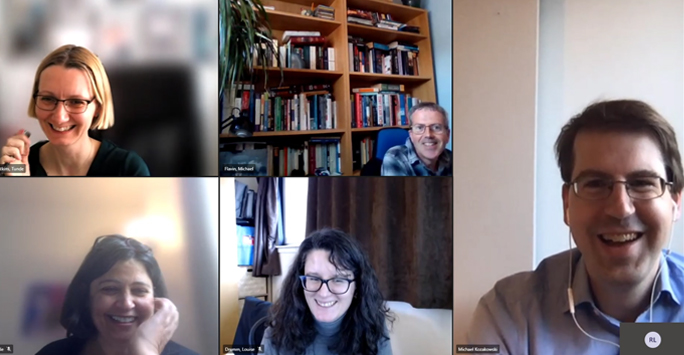Treasure Island Pedagogies: Episode 7 - the one with the ukulele
Posted on: 30 April 2021 by Dr Tunde Varga-Atkins in General

In Episode 7, learning is slow-burning, it takes time to nurture and it is great when it all comes together at the end. Our guests also discuss the potential of multimodal learning, through visual imagery, doodling, sketching or drawing.
Speakers: Dr Louise Drumm, Dr Vicki Dale, Dr Michael Flavin and Dr Michael Kozakowski
Date: 27 April 2021
This is a special edition of Treasure Island Pedagogies with educational developers. In homage to BBC Radio 4’s ‘Desert Island Discs’, our guests identify their students’ lightbulb moment (when their students ‘were getting it’), a teaching prop or pedagogy to take to their Treasure Islands together with a luxury item off duty.
Treasure Island Pedagogies: Episode 7 podcast
(Treasure Island Pedagogies Episode 7 - Podcast Transcript)
This episode features:
Dr Louise Drumm
Edinburgh Napier University, Scotland
- Lightbulb moment: they tend to be slow-burning moments, arising from slow conceptual changes, for instance when my participants shift away from thinking about technology as a shiny new thing to solve problems to critically observing their use in social contexts and the importance of centering on people and care.
- Teaching prop or pedagogy: Paper and pencils. Using old technology, sketch-noting, doodling, scribbling, enables us to consider how we think and how we learn.
- Luxury item: I am handy at DIY so can imagine whittling away bits of wood and shaping them into a ukulele. During lockdown, I ran an online course on learning the ukulele to experience what it was like learning from scratch.
Dr Michael Flavin
King’s College London, England
- Lightbulb moment: my lightbulb moment is more mine than my students: I work with students in prisons and psychiatric units. My last student, convicted in teenage years, referenced Foucault, Derrida and Lacan on the first page of his work. There can be a thin line between their world and our world. Teaching is about how you create this space for students to flourish.
- Teaching prop or pedagogy: A book. Any book: a magnificent springboard to new thoughts and ideas. They can work on a number of levels, take ‘An ABC, for Baby Patriots’ from 1889, an alphabet for little children for instance. It can also be critiqued as a product of British colonialism.
- Luxury item: I am (a very bad) classical guitarist so hoping for lots of practice time on the Island.
Dr Michael Kozakowski
Central European University, Vienna/Budapest
- Lightbulb moment: moving away from relying on assessment design to answer students’ question on “what to do for a first?” to focusing on what the skills are that I wanted student to develop to be better in analyzing, supporting arguments, researching, and communicating.
- Teaching prop or pedagogy: ways to get beyond text through visual imagery. Images allow us to slow down the interpretative process. Instead of jumping to the what does this image mean, I’d start asking students ‘what do you see’? Close observation can be a more democratic way of participation, then slowly make conclusions in a guided process.
- Luxury item: I would love to parachute my piano into the Island. Failing that, I’ll bring a pair of trainers for running.
Dr Vicki Dale
University of Glasgow, Scotland
- Lightbulb moment: my students are academic staff on our PGCAP programme. We purposely build on a narrative arc that includes dissonance, so when our participants are introduced to new pedagogies, such as object-based learning, they need to figure out how they can apply them to their practice. Their light bulb moment really comes together by when they submit their assessment, critical reflections and receive peer feedback.
- Teaching prop or pedagogy: you wouldn’t be surprised that as an archaeologist, I’d go for object-based learning, which lends itself to inquiry-based learning. What does it look and feel like, what’s it made of, who made it, when and what for? How do we interpret that? Another layer could be that people would come with their different disciplinary lenses and interview the objects, sharing these conversations.
- Luxury item: Last year, I would have said an art materials for their therapeutic aspect. Now: it’s Sherlock-Holmes-type board games, playing collaboratively, e.g. 221b Baker Street.
Any sparks? Bartering?
Learning takes time was definitely one theme of today’s conversation. Learning is slow-burning, it takes time to nurture and it is great when it all comes together at the end. Another theme was the importance and potential of multimodal learning, whether through visual imagery, doodling, sketching or drawing. Continuing with different modalities, object-based learning was definitely something that was being bartered by today’s guests. We also agreed that in our academic development work there is an undercurrent (or main) interest in digital technologies for education, but despite this, none of us chose sophisticated technologies for our teaching prop and pedagogy. Learning is not about technology. Technology can help mediate learning, but critical thinking and engagement, constructivism are more important. Finally, watch out for our band is forming ahead of the Royal Variety show with Michael K’s piano, Michael F’s guitar and Louise’s ukulele, to entertain all of us on our Treasure Islands.
Links / resources
- Medieval lecture theatre
- Inquiry graphics in HE – for those interested in exploring the use of graphics and images for inquiry-based learning by Natasa Lackovic
- The Hunterian Museum
Facilitated by Tünde Varga-Atkins, Audio/Producer by Rob Lindsay, Web design: Dennis Wong, @LivUniCIE
Keywords: Treasure Island Pedagogies, Podcast, Innovation, Education, Interdisciplinary, Connectedness, Signature Pedagogies.